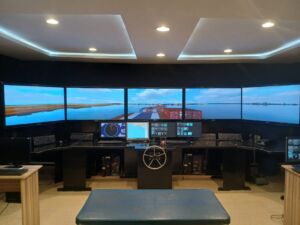
Global Maritime Distress And Safety System (GMDSS)
Advance Courses
|
5 days
|
English
|
OnsiteDescription
The Global Maritime Distress and Safety System (GMDSS) course is designed to train seafarers in the use of the GMDSS equipment and procedures, ensuring they are capable of managing communications in distress and safety situations at sea. The GMDSS is an internationally agreed-upon set of safety procedures, types of equipment, and communication protocols used to increase safety and make it easier to rescue distressed ships, boats, and aircraft.
Course Curriculum
- Introduction to GMDSS
- Overview of the GMDSS and its purpose.
- History and development of GMDSS.
- Components and functions of the GMDSS.
- GMDSS Regulations and Requirements
- International regulations and SOLAS (Safety of Life at Sea) Convention requirements.
- The role of the International Maritime Organization (IMO) in GMDSS.
- Certification and licensing requirements for GMDSS operators.
- GMDSS Equipment
- Types of GMDSS equipment: VHF, MF/HF radio systems, Inmarsat, EPIRBs, SARTs, NAVTEX.
- Installation, operation, and maintenance of GMDSS equipment.
- Power sources and battery maintenance for GMDSS equipment.
- Distress, Urgency, and Safety Communications
- Procedures for sending distress alerts and messages.
- Handling urgency and safety communications.
- Communication protocols and formats for distress signals.
- Search and Rescue (SAR) Operations
- Role of GMDSS in search and rescue operations.
- Coordination with rescue coordination centers (RCCs) and other SAR authorities.
- Use of GMDSS equipment in SAR scenarios.
- Digital Selective Calling (DSC)
- Principles and operation of DSC.
- Procedures for sending and receiving DSC distress alerts.
- Use of DSC in routine, urgency, and safety communications.
- Satellite Communications
- Overview of Inmarsat systems and services.
- Operating procedures for Inmarsat terminals.
- Role of satellites in GMDSS.
- Radio Communication Procedures
- Standard maritime communication procedures and protocols.
- Use of the phonetic alphabet and standard marine communication phrases.
- Maintaining a communication log and record-keeping.
- Navigational Warnings and Weather Information
- Receiving and interpreting NAVTEX messages.
- Accessing maritime safety information (MSI) broadcasts.
- Understanding weather forecasts and navigational warnings.
- Practical Exercises and Simulations
- Hands-on training with GMDSS equipment.
- Simulated distress and safety communication scenarios.
- Practical exercises to reinforce theoretical knowledge.
Course Duration and Certification
- Duration: Typically 5 to 10 days, depending on the training provider and course structure.
- Certification: Successful completion of the course awards a GMDSS General Operator’s Certificate (GOC) or Restricted Operator’s Certificate (ROC), depending on the level of training and the type of equipment covered.
Importance
- Safety: Ensures seafarers are proficient in using GMDSS equipment to enhance safety at sea.
- Regulatory Compliance: Meets international maritime communication standards and SOLAS requirements.
- Effective Communication: Enhances the ability to manage distress, urgency, and safety communications efficiently.
The GMDSS course is essential for maritime professionals, equipping them with the skills to operate critical communication equipment and manage distress and safety communications, thereby contributing to the overall safety and security of maritime operations.
- Category Advance Courses
- Language English
- Duration 5 days
- Level Advanced
- Assessments Yes
Reviews
4.5
Limited Time Offer